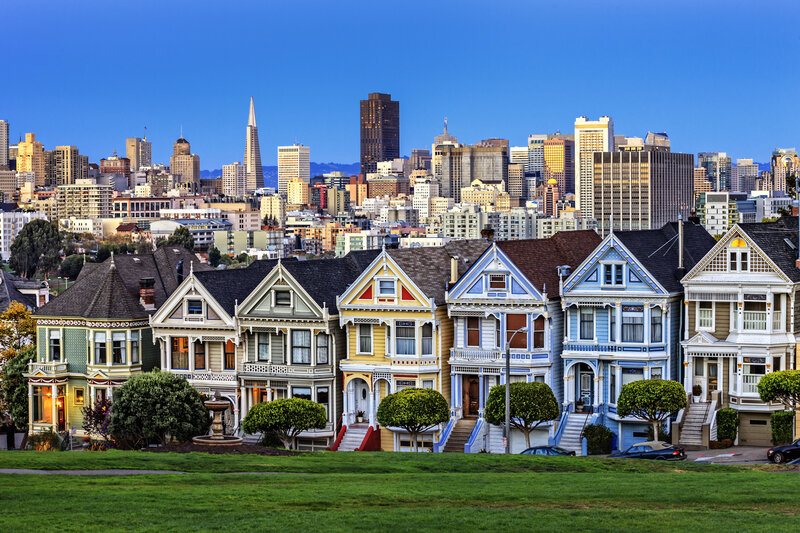-

The Bay Area is fortunate to have so many historic homes, creating a visual progression of architecture spanning the 19th and 20th centuries. Each period and architectural style is preserved by selecting roofing materials that match your home’s original design intention.
Picking The Right Roof Materials For Any Historic Home
First and foremost, it’s worth checking in with the historical society in your city or town. If your home is already on the historic homes registry or qualifies to make the cut, you’ll receive specific instructions regarding how to renovate the roof in compliance with their requirements. For example, according to the San Francisco Historic Planning Department, the benefits of listing a home on the historic home registry include potential reductions in property tax, access to rehabilitation/renovation grants, and appreciated home value.
Regardless of whether a home is officially on the registry, it’s important to maintain an exterior aligned with its architectural style. Here are tips on how to do that.
Work With A Licensed Roofing Contractor With Historic Home Roof Experience
You must find a local, licensed roofing contractor who has historic home experience. Make sure to interview at least three different roofing contractors when making your choice, and ask to see pictures of the historic home roof renovations they’ve completed in the past year or two.
While we’re sharing the most authentic roofing materials as examples below, your roofing contractor can share mock alternatives that replicate historical materials but are more affordable or fire-resistant alternatives, depending on your priorities and budget.
Know The Architectural Style Of Your Historic Home
There’s no guarantee that the current roof aligns with the home’s original architectural intent. If you aren’t sure what style your home is, do a little research. Most of the historical homes in the San Francisco Bay Area fall into the following styles:
Victorian (1860-1890)
These homes have a tremendous amount of ornate detail as well as steeply gabled roofs. They are often referred to as doll houses or gingerbread houses due to their ornate decoration. They were also called “Victorian Stick” homes due to the use of long, slender pieces of decorative wood. San Francisco and the Bay Area have the largest concentration of Victorian homes anywhere in the world.
The best roofing materials for Victorian Homes are slate or wood shingles.
Queen Anne (1880-1910)
Queen Anne homes moved forward with the ornate decoration trends that started with Victorian homes. These homes took the embellishment to newer extremes, adding roof lines that intersect, bay windows, balconies, and porches. They also shocked the world with their flamboyant color combinations.
The most common roofing material for Queen Anne homes is slate.
Shingle Style (1880-1910)
Intersection with the Victorian-era homes was shingle-style designs. This architectural home style started in New England and spread west, as opposed to other styles inspired by England. As a result, shingle-style homes were less ornate and more rustic in their design. And, as the name suggests, shingles comprised exterior aesthetics as well as the roof.
While wood shingles are the most common historic option but well-selected asphalt shingles complementing exterior wood shingles would suffice.
Edwardian (1900-1930)
Many of San Francisco and the Bay Area’s historical homes were destroyed by earthquakes or fires. As a result, there are large numbers of Edwardian Homes built well into the 1920s and 30s. This architectural style is a mash-up of Victorian, Georgian, and Art Nouveau styles, simplifying ornate decoration but including domed pavilions. The color palette is also muted compared with Victorian aesthetics.
The best roofing materials for Edwardian homes are clay tiles, beautifully replicated in metal roof options.
Mission Revival (1890-1920)
Mission revival architecture celebrated the cooling and warming benefits of an adobe (or stucco) exterior and tile roofs. Aficionados of Mission Revival architecture also appreciated its simplicity when compared with more ornate historical styles. Also, these homes were naturally more fireproof, which was another major bonus for those devastated by early 20th-century fires.
Spanish tiles are the ideal roofing material for a mission revival home. Metal roofing manufacturers do a wonderful job of replicating Spanish tiles or you can select shingle or simpler metal roofing designs in a Spanish tile hue.
Craftsman (1910-1920)
Craftsman-style homes enjoyed a short building period but are very popular in the real estate market. They are recognized by their round-columned porches with stone supports, gable roofs, wide eaves, exposed rafters, and handcrafted stone or woodworking. Ultimately, these homes were a public response to rapid industrialization, which caused craftsman to promote their skills to protect themselves from being replaced by machines.
Craftsman homes are most often renovated using well-selected asphalt shingles due to the architectural styles’ celebration of different textures.
Streamline to Mid-Century Modern (1930-1960s)
The Streamline and Mid-Century Modern eras were all about clean lines, streamlining, and simplicity. This is where we see the flattest roofs, so beware of the tendency toward ponding water. These homes could be as simple as concrete or include more warm and earthy elements like wood.
Usually, we use asphalt shingles as they are durable, affordable, and invisible in a flat roof design.
Schedule A Free Assessment With An Experience Historic Home Roofer
The team at Central Bay Roofing has more than 40 years of experience restoring and maintaining some of the Bay Area’s most beautiful historic homes. Contact us, at (510) 521-7334, to schedule a free, no-obligation assessment.
Choosing Roof Materials For Your Historic Home
Call Us On (510) 521-7334
Your Local Roofers Since 1978
We invite you to contact us today for an estimate on your roofing project.
1814 Clement Avenue Alameda, CA 94501
(510) 521-7334
info@centralbayroofing.comLicense: 435272 Class B, C-39
Site powered by RooferBoost
Copyright 2017 Central Bay Roofing and Restoration | Login
